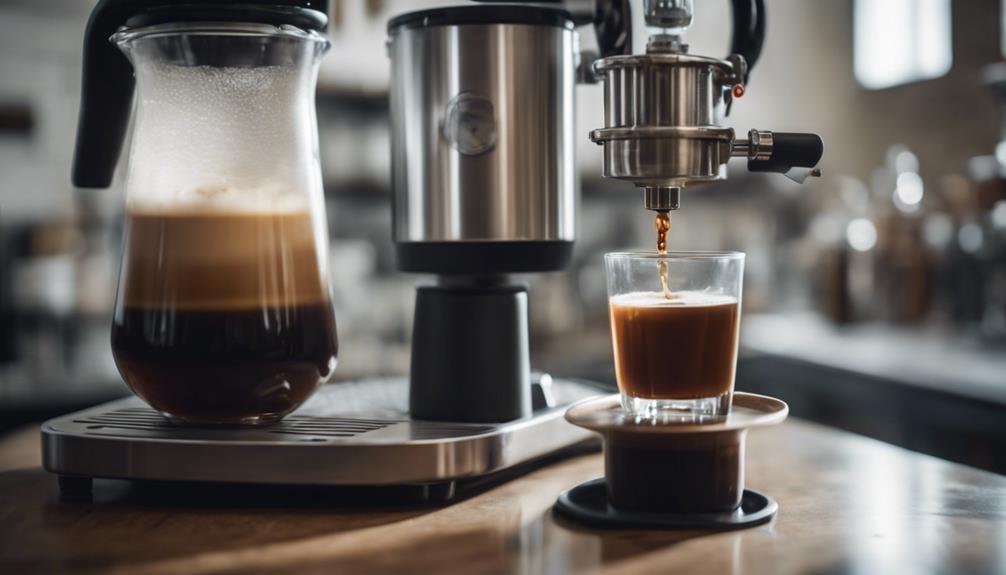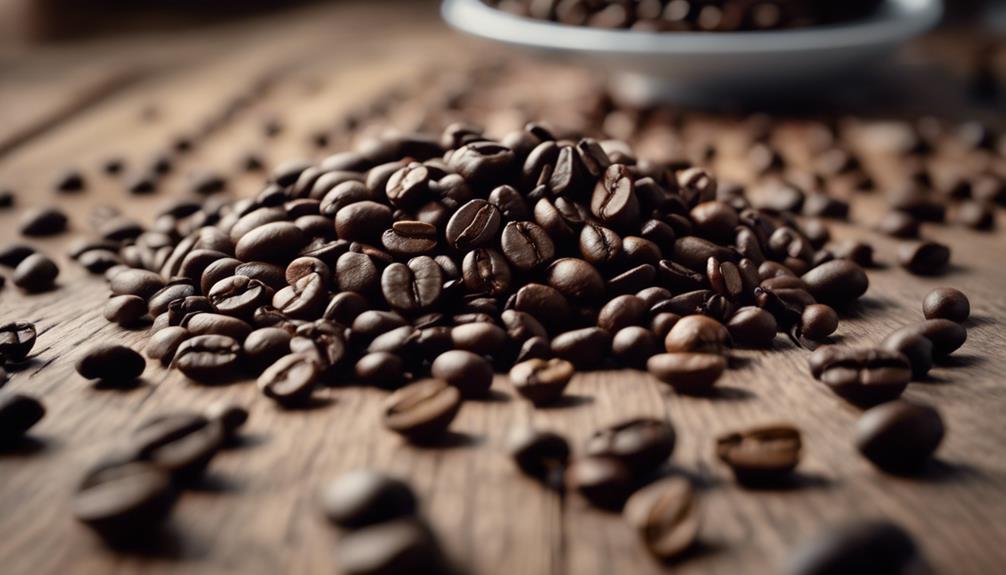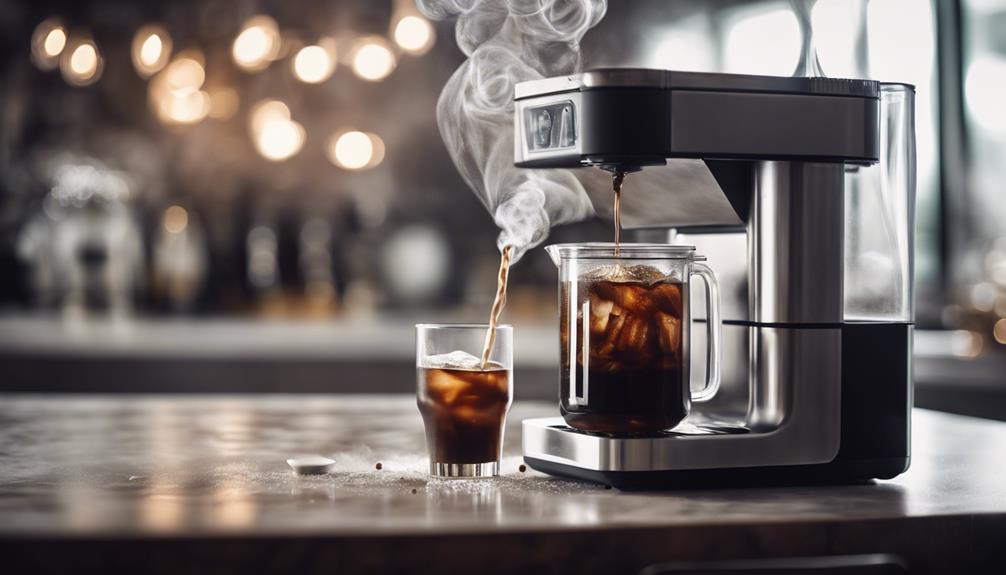Sous Vide Cold Brew Coffee: Rich and Smooth
Crafted with precision, Sous Vide Cold Brew Coffee offers a rich, smooth taste. By regulating temperature and brewing time, it reveals deep flavors not found in traditional methods. The result? A luxurious coffee experience like no other, boasting a wide range of flavors. Want to discover more about how this process reveals your favorite morning drink?
What You Will Learn Here
- Controlled temperature in sous vide brewing enhances flavor extraction.
- Extended brewing time results in a rich and smooth coffee concentrate.
- Reduced acidity and bitterness compared to traditional cold brew methods.
- Wide range of flavor profiles achieved through precise extraction process.
- Versatile for various servings including iced coffee, cocktails, and desserts.
Coffee Evolution Over Time

As you explore the evolution of coffee over time, consider the intricate interplay between various brewing methods. The historical roots of coffee cultivation and the ever-evolving trends shaping the modern coffee landscape. Understanding how different brewing techniques have developed and influenced coffee's journey can provide a fascinating glimpse into its rich history and cultural significance.
Coffee Brewing Methods
The evolution of coffee brewing methods throughout history showcases the continual refinement and innovation in the quest for the perfect cup of coffee. Espresso brewing, with its high-pressure extraction method, revolutionized the coffee world by producing a concentrated and rich brew in a matter of seconds.
French press techniques, on the other hand, focus on immersion brewing, where coarse coffee grounds are steeped in hot water before being pressed down through a filter. These methods represent just a fraction of the diverse brewing techniques that have emerged over time, each providing a unique experience and flavor profile.
From pour-over methods to cold brew processes, the world of coffee brewing continues to expand, offering coffee enthusiasts a wide array of options to explore and enjoy.
Historical Coffee Origins
Investigating the historical beginnings of coffee reveals a vibrant fabric of cultural importance and worldwide impact. Coffee, originating from Ethiopia in the 9th century, quickly spread across the Arabian Peninsula, where the first coffeehouses emerged. These establishments became hubs for social gatherings, stimulating intellectual discussions, and fostering the development of coffee rituals.
As coffee made its way to Europe and the Americas, its global impact intensified, shaping trade routes, economies, and social interactions. The 17th century saw the rise of coffeehouses in major cities like London and Paris, becoming centers for political debates and social exchange.
This rich history illustrates how coffee evolved from a simple beverage to a symbol of cultural exchange and global interconnectedness.
Modern Coffee Trends
Delving into the contemporary coffee landscape reveals a dynamic evolution marked by innovative brewing methods and evolving consumer preferences.
Nitro coffee, a trend that has emerged in recent years, involves infusing cold brew coffee with nitrogen gas, creating a creamy texture and a smooth, velvety mouthfeel. This method has gained popularity for its unique presentation and enhanced flavor profile.
Additionally, coffee cocktails have become increasingly prevalent, blending the rich flavors of coffee with various spirits and mixers to create sophisticated and complex beverages. These concoctions cater to a diverse audience seeking novel ways to enjoy their favorite caffeinated beverages.
As the coffee industry continues to evolve, these modern trends showcase the creativity and adaptability of the ever-expanding coffee culture.
Coffee Bean Varieties

When selecting coffee bean varieties for sous vide cold brew coffee, consider the roast level and origin to achieve the desired flavor profile. Here are some factors to keep in mind:
- Arabica vs Robusta: Arabica beans are known for their smooth, aromatic flavors, while Robusta beans offer a stronger, more bitter taste. Choose based on your preference for flavor intensity.
- Single origin vs blend: Single-origin beans come from a specific region, offering unique flavor profiles, while blends combine beans from different origins to create a balanced taste. Decide whether you prefer nuanced flavors or a more consistent blend.
- Roast Level: Lighter roasts preserve the bean's original flavors, while darker roasts have a richer, more intense taste. Consider how the roast level will complement the brewing method.
- Origin: Different regions produce beans with distinct flavors influenced by factors like altitude and soil composition. Experiment with beans from various origins to find your favorite flavor profiles.
- Grind Size: The grind size affects the extraction rate and the final flavor of the coffee. Adjust the grind size based on your brewing method to achieve the perfect balance of flavors.
Chilled Caramel Cold Brew
When making Chilled Caramel Cold Brew, the ASPECTS to keep in mind are:
- The Cold Brew Concentrate Recipe
- Unique Cold Brew Infusion
- The Cold Brew Float Recipe
These elements will guide you in creating a flavorful and INVIGORATING beverage. Each point offers a distinct element to enhance your Chilled Caramel Cold Brew experience.
Cold Brew Concentrate Recipe
For crafting a rich and flavorful Chilled Caramel Cold Brew, start by preparing a concentrated cold brew base using your preferred method. To guarantee the best taste experience, consider the following steps:
- Select Quality Beans: Choose high-quality coffee beans with flavor profiles that complement caramel notes.
- Grind Consistently: Grind your beans to a coarse consistency to extract the right flavors.
- Brew Time: Opt for a longer brew time to enhance the richness of the cold brew.
- Proper Dilution: When serving, dilute the concentrate with water or milk to achieve your desired strength.
- Taste Testing: Regularly taste test your cold brew concentrate to adjust the flavor to your liking.
Unique Cold Brew Infusion
To infuse a unique twist into your Chilled Caramel Cold Brew, experiment with adding complementary flavors through a creative infusion process. When exploring flavor profiles, consider pairing caramel with hints of vanilla or a sprinkle of sea salt for a delightful contrast.
Embrace infusion techniques like steeping cinnamon sticks or adding a touch of almond extract to elevate the complexity of your cold brew. Utilize your cold brew gear to guarantee a consistent and smooth infusion process.
Serve your Chilled Caramel Cold Brew over ice for an invigorating experience, or try it with a dollop of whipped cream for added indulgence. Enjoy the rich and smooth flavors of your unique creation!
Cold Brew Float Recipe
Enhance your Chilled Caramel Cold Brew experience with a delectable Cold Brew Float Recipe. When it comes to enjoying cold brew cocktails and exploring unique coffee pairings, this recipe is a must-try. Follow these simple steps to elevate your coffee experience:
- Ingredients: Gather vanilla ice cream, caramel sauce, whipped cream, and a shot of cold brew.
- Assembly: Scoop the vanilla ice cream into a glass, drizzle with caramel sauce, and pour the cold brew shot over it.
- Top it Off: Add a dollop of whipped cream on top for an extra indulgent touch.
- Enjoy: Grab a spoon and a straw to savor the layers of rich flavors.
- Variations: Experiment with different ice cream flavors or swap caramel for chocolate syrup for a personalized twist.
Cold Brew Brewing Techniques
When preparing cold brew coffee, important factors like steeping time options, water-to-coffee ratio, and filtration methods greatly impact the final product.
Adjusting the steeping time can control the strength and flavor extraction of the brew, while the right water-to-coffee ratio guarantees a balanced and rich taste.
Filtration techniques play a key role in removing sediments and achieving a clean, smooth cold brew coffee.
Steeping Time Options
Consider experimenting with different steeping times to extract varying levels of flavor and strength from your cold brew coffee. Steeping time is a critical factor that affects the overall taste profile of your cold brew. Here are some steeping time options to help you customize your brew to perfection:
| Steeping Time | Flavor Intensity | Strength Level |
|---|---|---|
| 12 hours | Medium | Mild |
| 18 hours | Bold | Medium |
| 24 hours | Strong | Strong |
| 30 hours | Intense | Robust |
| 36 hours | Rich | Powerful |
Experiment with these different steeping times based on your preferences to achieve the ideal balance of flavor and strength in your sous vide cold brew coffee.
Water-to-Coffee Ratio
What key factor greatly influences the taste and strength of your sous vide cold brew coffee?
The water-to-coffee ratio plays a pivotal role in achieving brewing consistency and revealing desired flavor profiles. When determining the ratio, it's important to take into account extraction efficiency and individual taste preferences.
A higher coffee-to-water ratio typically results in a stronger brew with more pronounced flavors, while a lower ratio may produce a milder taste. Experimenting with different ratios allows you to fine-tune your cold brew to suit your palate.
Keep in mind that the water-to-coffee ratio is a critical variable that can have a significant impact on the overall quality of your sous vide cold brew coffee, so adjust it according to your preferences for a truly customized experience.
Filtration Methods
To enhance the efficiency and quality of your sous vide cold brew coffee, selecting an appropriate filtration method is essential in cold brew brewing techniques. The filtration efficiency directly impacts the extraction rates of your cold brew, affecting both cold brew clarity and flavor retention.
When choosing a filtration method, consider factors such as pore size and material composition to optimize the extraction process. Finer filters can result in a cleaner cup with enhanced clarity, while coarser filters may allow more oils and sediment to pass through, influencing flavor retention.
Experiment with different filtration methods to find the one that best suits your preferences for a smooth and rich sous vide cold brew coffee experience.
Final Thoughts
In conclusion, the sous vide cold brew coffee method offers a convenient and innovative way to achieve a smooth and flavorful coffee concentrate. The controlled temperature and extended brewing time result in a rich coffee with a unique taste profile that's less acidic and bitter compared to traditional brewing methods. This process allows for the extraction of a wide range of flavor profiles, from chocolatey and nutty notes to fruity and floral undertones, providing a versatile drinking experience for coffee enthusiasts.
When it comes to serving suggestions, the concentrated nature of sous vide cold brew coffee allows for flexibility in how you enjoy it. Dilute it with water or milk for a classic iced coffee, mix it with syrups and cream for a decadent dessert-like treat, or even use it as a base for cocktails to add a sophisticated coffee twist. Experimenting with different ratios and ingredients can help you tailor the flavor to your preference, making sous vide cold brew coffee a customizable and enjoyable beverage option.
Frequently Asked Questions
How Does Sous Vide Cold Brew Coffee Compare to Traditional Cold Brew Methods in Terms of Flavor and Texture?
When comparing sous vide cold brew coffee to traditional methods, you'll notice a more consistent flavor profile due to longer brewing times. The smoothness stems from the controlled extraction process in sous vide, resulting in a rich and velvety texture.
Can Different Types of Coffee Beans Affect the Taste of Sous Vide Cold Brew Coffee?
Different types of coffee beans can notably alter the taste of sous vide cold brew coffee. Roast profiles and brewing time affect flavor complexity and intensity. Experiment with various beans to find your preferred taste profile.
Is It Possible to Adjust the Strength of the Coffee When Using the Sous Vide Method?
To adjust the strength of coffee using the sous vide method, vary brewing time. Longer times yield stronger brews. Experiment with different durations to find your ideal balance. This method offers precise control over your coffee's potency.
Are There Any Specific Recommendations for Storage and Shelf Life of Sous Vide Cold Brew Coffee?
When storing sous vide cold brew coffee, guarantee airtight containers for freshness. Refrigerate promptly, maintaining quality for up to two weeks. Preserve by freezing in ice cube trays for long-term use. Maximize shelf life with these tips.
How Does the Sous Vide Method Impact the Caffeine Content of the Cold Brew Coffee Compared to Other Brewing Techniques?
When comparing caffeine extraction in brewing techniques, sous vide stands out for its precise control, which can impact caffeine levels. This method optimizes extraction efficiency, potentially resulting in a higher caffeine content compared to traditional brewing methods.
Conclusion
To sum up, sous vide cold brew coffee offers a rich and smooth flavor profile that's unmatched by traditional brewing methods. By carefully controlling the temperature and time, the intricate flavors of the coffee beans are extracted to perfection.
This technique allows for a consistent and delicious cold brew coffee every time. Embrace the evolution of coffee brewing with sous vide cold brew for a truly exceptional coffee experience.









